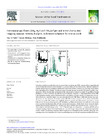Greenhouse gas fluxes (CO2, N2O and CH4) of pea and maize during two cropping seasons: Drivers, budgets, and emission factors for nitrous oxide
dc.contributor.author
Maier, Regine
dc.contributor.author
Hörtnagl, Lukas
dc.contributor.author
Buchmann, Nina
dc.date.accessioned
2022-08-15T06:38:52Z
dc.date.available
2022-08-13T08:54:15Z
dc.date.available
2022-08-15T06:38:52Z
dc.date.issued
2022-11-25
dc.identifier.issn
0048-9697
dc.identifier.issn
1879-1026
dc.identifier.other
10.1016/j.scitotenv.2022.157541
en_US
dc.identifier.uri
http://hdl.handle.net/20.500.11850/563569
dc.identifier.doi
10.3929/ethz-b-000563569
dc.description.abstract
Agriculture contributes considerably to the increase of global greenhouse gas (GHG) emissions. Hence, magnitude and drivers of temporal variations in carbon dioxide (CO2), nitrous oxide (N2O) and methane (CH4) fluxes in croplands are urgently needed to develop sustainable, climate-smart agricultural practices. However, our knowledge of GHG fluxes from croplands is still very limited. The eddy covariance technique was used to quantify GHG budgets and N2O emission factors (EF) for pea and maize in Switzerland. The random forest technique was applied for gap-filling N2O and CH4 fluxes as well as to determine the relevance of environmental, vegetation vs. management drivers of the GHG fluxes during two cropping seasons. Environmental (i.e., net radiation, soil water content, soil temperature) and vegetation drivers (i.e., vegetation height) were more important drivers for GHG fluxes at field scale than time since management for the two crop species. Both crops acted as GHG sinks between sowing and harvest, clearly dominated by net CO2 fluxes, while CH4 emissions were negligible. However, considerable N2O emissions occurred in both crop fields early in the season when crops were still establishing. N2O fluxes in both crops were small later in the season when vegetation was tall, despite high soil water contents and temperatures. Results clearly show a strong and highly dynamic microbial-plant competition for N driving N2O fluxes at the field scale. The total loss was 1.4 kg N2O-N ha−1 over 55 days for pea and 4.8 kg N2O-N ha−1 over 127 days for maize. EFs of N2O were 1.5 % (pea) and 4.4 % (maize) during the cropping seasons, clearly exceeding the IPCC Tier 1 EF for N2O. Thus, sustainable, climate-smart agriculture needs to consider crop phenology and better adapt N supply to crop N demand for growth, particularly during the early cropping season when competition for N between establishing crops and soil microorganisms modulates N2O losses.
en_US
dc.format
application/pdf
en_US
dc.language.iso
en
en_US
dc.publisher
Elsevier
en_US
dc.rights.uri
http://creativecommons.org/licenses/by/4.0/
dc.subject
Corn
en_US
dc.subject
Legume
en_US
dc.subject
Eddy covariance
en_US
dc.subject
Agriculture
en_US
dc.subject
Arable land
en_US
dc.subject
Management
en_US
dc.title
Greenhouse gas fluxes (CO2, N2O and CH4) of pea and maize during two cropping seasons: Drivers, budgets, and emission factors for nitrous oxide
en_US
dc.type
Journal Article
dc.rights.license
Creative Commons Attribution 4.0 International
dc.date.published
2022-07-24
ethz.journal.title
Science of The Total Environment
ethz.journal.volume
849
en_US
ethz.journal.abbreviated
Sci. Total Environ.
ethz.pages.start
157541
en_US
ethz.size
14 p.
en_US
ethz.version.deposit
publishedVersion
en_US
ethz.grant
Reconciling innovative farming practices and networks to enable sustainable development of smart Swiss farming systems
en_US
ethz.identifier.wos
ethz.identifier.scopus
ethz.publication.place
Amsterdam
en_US
ethz.publication.status
published
en_US
ethz.leitzahl
ETH Zürich::00002 - ETH Zürich::00012 - Lehre und Forschung::00007 - Departemente::02350 - Dep. Umweltsystemwissenschaften / Dep. of Environmental Systems Science::02703 - Institut für Agrarwissenschaften / Institute of Agricultural Sciences::03648 - Buchmann, Nina / Buchmann, Nina
en_US
ethz.leitzahl.certified
ETH Zürich::00002 - ETH Zürich::00012 - Lehre und Forschung::00007 - Departemente::02350 - Dep. Umweltsystemwissenschaften / Dep. of Environmental Systems Science::02703 - Institut für Agrarwissenschaften / Institute of Agricultural Sciences::03648 - Buchmann, Nina / Buchmann, Nina
en_US
ethz.grant.agreementno
172433
ethz.grant.fundername
SNF
ethz.grant.funderDoi
10.13039/501100001711
ethz.grant.program
NFP 73: Gesuch
ethz.date.deposited
2022-08-13T08:54:22Z
ethz.source
FORM
ethz.eth
yes
en_US
ethz.availability
Open access
en_US
ethz.rosetta.installDate
2022-08-15T06:38:59Z
ethz.rosetta.lastUpdated
2023-02-07T05:17:38Z
ethz.rosetta.versionExported
true
ethz.COinS
ctx_ver=Z39.88-2004&rft_val_fmt=info:ofi/fmt:kev:mtx:journal&rft.atitle=Greenhouse%20gas%20fluxes%20(CO2,%20N2O%20and%20CH4)%20of%20pea%20and%20maize%20during%20two%20cropping%20seasons:%20Drivers,%20budgets,%20and%20emission%20factors%20for&rft.jtitle=Science%20of%20The%20Total%20Environment&rft.date=2022-11-25&rft.volume=849&rft.spage=157541&rft.issn=0048-9697&1879-1026&rft.au=Maier,%20Regine&H%C3%B6rtnagl,%20Lukas&Buchmann,%20Nina&rft.genre=article&rft_id=info:doi/10.1016/j.scitotenv.2022.157541&
Files in this item
Publication type
-
Journal Article [130627]

